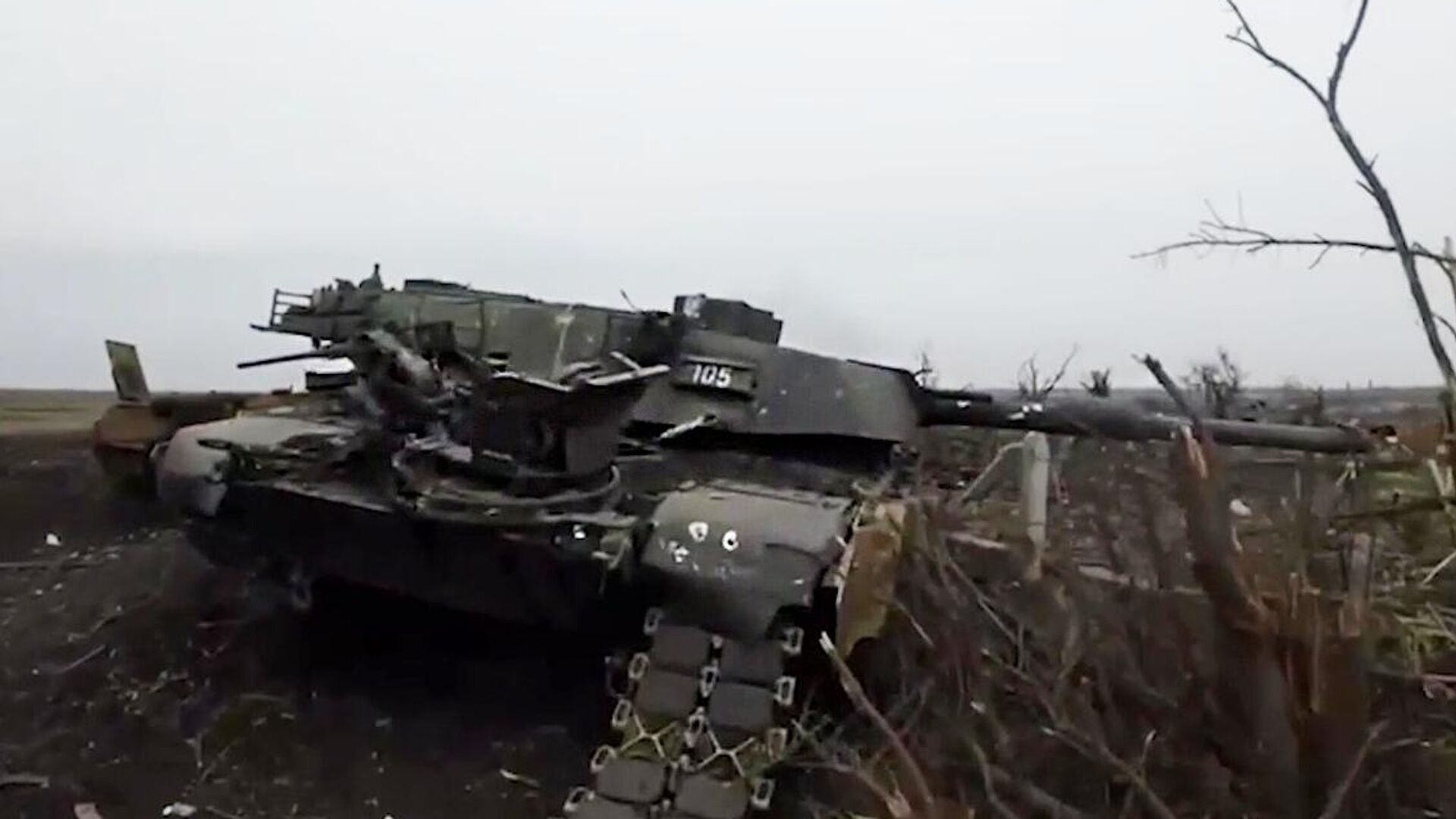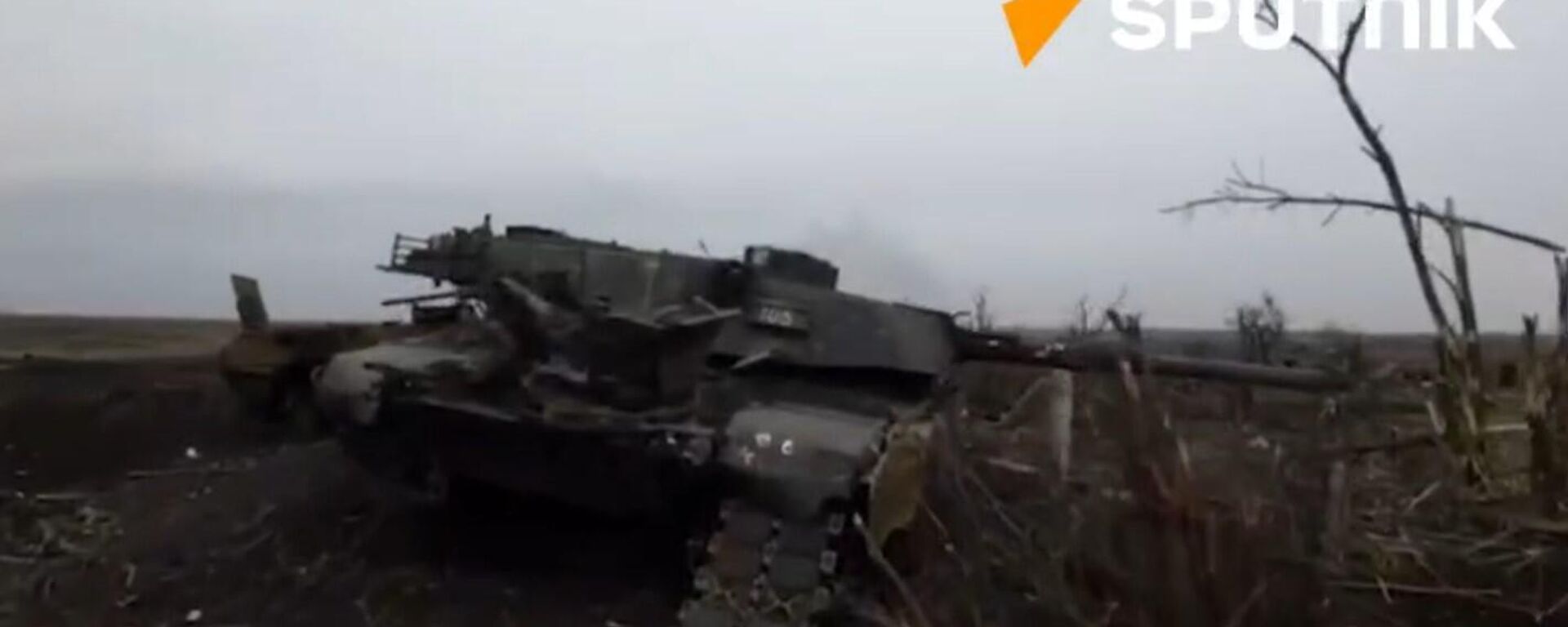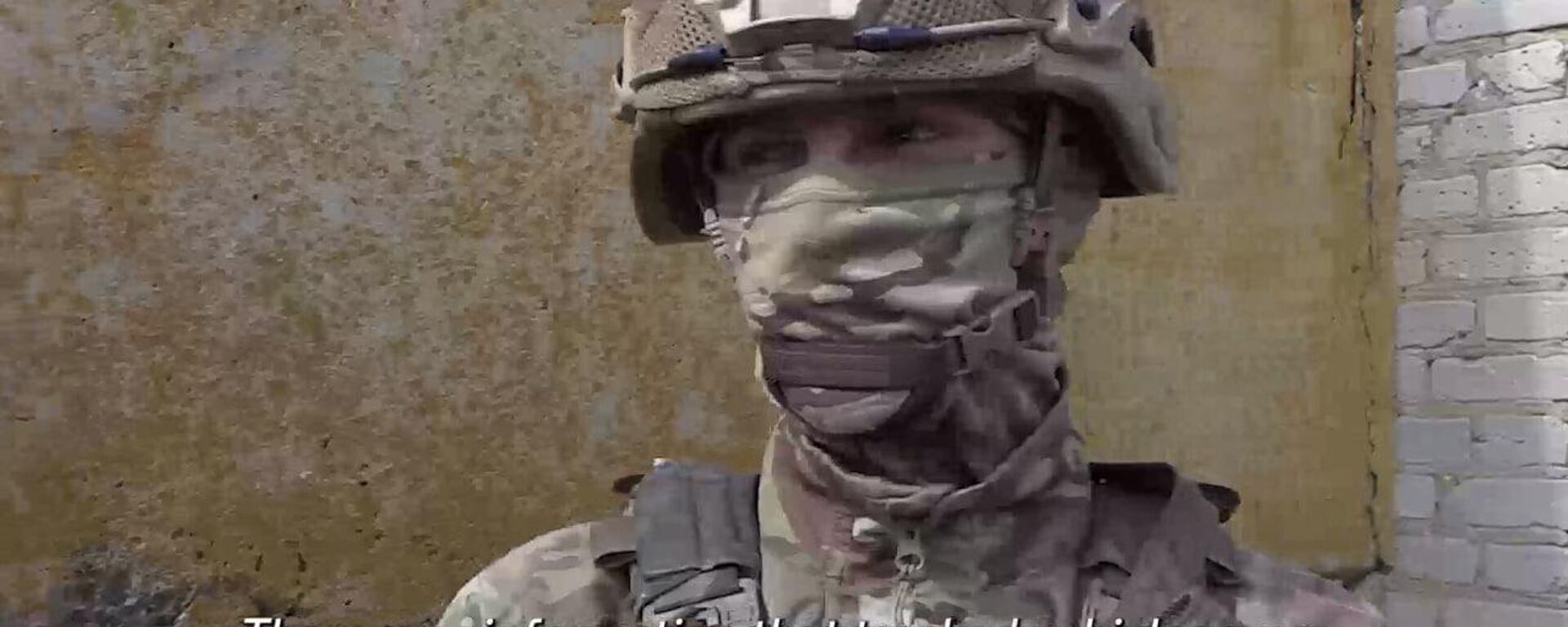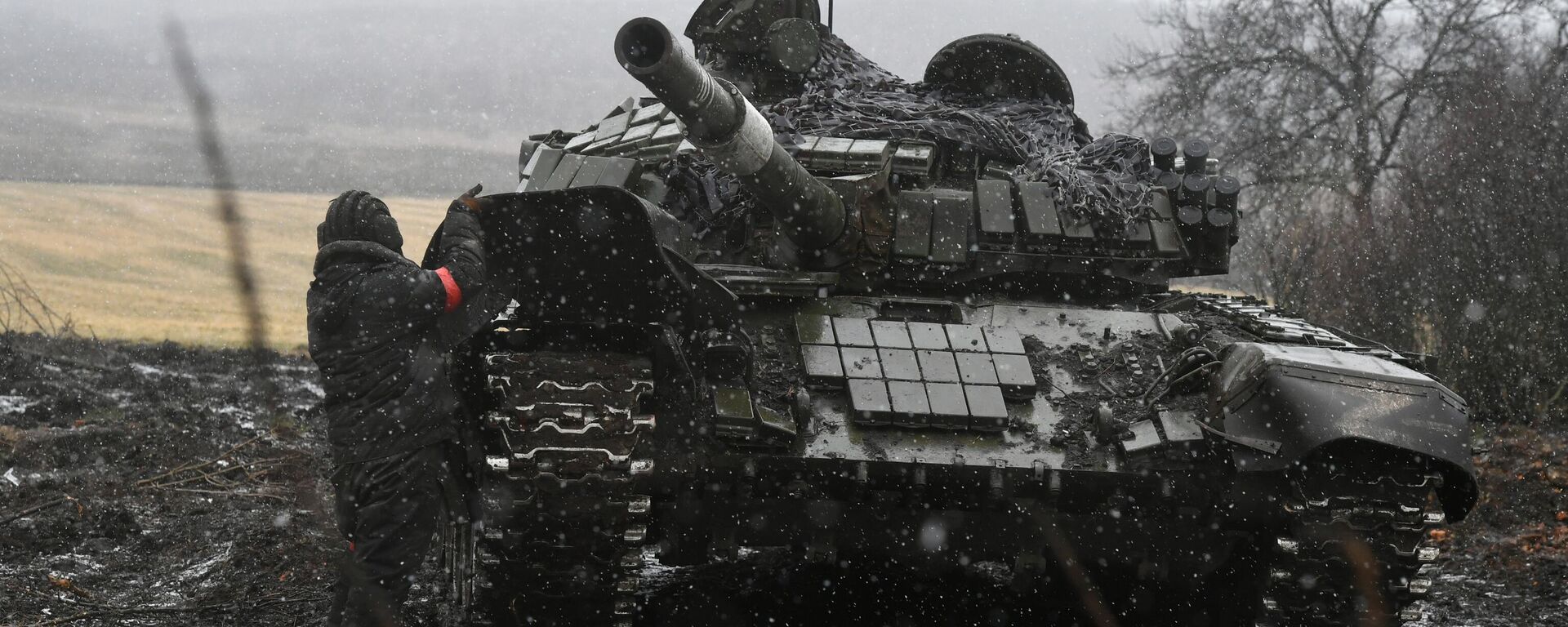https://sputnikglobe.com/20240320/cracking-open-the-abrams-what-russia-can-learn-by-studying-knocked-out-m1-1117448146.html
Cracking Open the Abrams: What Russia Can Learn by Studying Knocked Out M1
Cracking Open the Abrams: What Russia Can Learn by Studying Knocked Out M1
Sputnik International
Russia's Defense Ministry has released footage of special forces scouts inspecting a knocked out Ukrainian Abrams abandoned in no man’s land in the settlement of Berdychi, about 3 km northeast of Avdeyevka. Sputnik asked veteran military observer Alexei Leonkov what Russia could get out inspecting the vaunted American main battle tank more closely.
2024-03-20T11:40+0000
2024-03-20T11:40+0000
2024-03-20T13:10+0000
russia's special operation in ukraine
military & intelligence
alexei leonkov
ukraine
russia
rpg-7
nato
defense ministry
m1 abrams tank
m-1 abrams tank
https://cdn1.img.sputnikglobe.com/img/07e8/03/14/1117447982_0:28:1131:664_1920x0_80_0_0_5be894fc0a67f1b7a7078d74f92698e3.jpg
Battlegroup Tsentr scouts have completed a risky operation to inspect a damaged Abrams MBT, collecting evidence for analysis by command.The soldier said that approaching the damaged tank was no easy matter, with Ukrainian troops very close by, hunter-killer drones circling overhead, and artillery firing regularly.For now, neither side’s forces can approach the tank in vehicles. “Any equipment driving up to collect this Abrams would remain there. There’s no point for them, they would suffer unnecessary losses,” senior intelligence officer with the call sign "Izay," the trooper whose helmet cam captured the dramatic footage inside the damaged Abrams, explained.What Could Russia Get by Studying the Abrams?The Abrams fielded by Ukraine are simplified, "monkey model" variants of the American main battle tank, featuring the same hull and turret design, but without an array of specialized onboard equipment, from uranium armor plating and advanced fire control systems to drone detection tools.But before that, “all the parameters will be recorded, a ‘digital twin’ will be created, so that later this information can, for example, be entered into our reconnaissance systems,” (i.e. the library of images to enable them to quickly identify Abrams on the battlefield).“In other words, the field of study is quite extensive,” Leonkov said.The poor performance of the Abrams and other Western main battle tanks operating Ukraine has been documented extensively by the Russian military, independent observers, and even Western and Ukrainian media. An expose in The Kyiv Post on Tuesday compared NATO’s “big-ticket, expensive, heavily armored” tanks to “overweight duds,” and suggested that the Western alliance should never have handed them over to Ukraine in the first place.Iraq War vet and former Abrams commander Mike Riedmuller said the M1 hasn’t been able to perform "up to expectations" in Ukraine due to the density of cheap drones on the battlefield, which have made armored operations virtually impossible. “A mobility kill invites a swarm of cheap drones that can drop grenades show up and change the mobility kill into a catastrophic kill pretty quickly, no artillery needed,” Riedmuller said.Besides this, the tanks NATO has sent eastward have a slew of other problems, from poor performance in the local steppe and mud-filled landscape, to parts shortages and excessive fuel consumption, as well as mobility issues stemming from the armor being too heavy to cross some local bridges.Realizing this, especially after last year’s disastrous summer counteroffensive, Ukraine’s military has resorted to using its remaining tanks – both NATO and Soviet ones, more sparingly and in smaller numbers, often in wooded areas and poor weather to avoid rapid detection and targeting.
https://sputnikglobe.com/20240320/watch-russian-special-forces-reach-destroyed-us-made-abrams-tank-in-special-op-zone-1117441018.html
https://sputnikglobe.com/20240320/russian-scout-who-destroyed-us-made-abrams-recalls-what-it-was-like-1117441413.html
https://sputnikglobe.com/20240307/what-helped-russias-t-72b3-tank-destroy-ukraines-abrams-1117192733.html
ukraine
russia
Sputnik International
feedback@sputniknews.com
+74956456601
MIA „Rossiya Segodnya“
2024
News
en_EN
Sputnik International
feedback@sputniknews.com
+74956456601
MIA „Rossiya Segodnya“
Sputnik International
feedback@sputniknews.com
+74956456601
MIA „Rossiya Segodnya“
what can russia learn from abrams tanks, will russia study abrams tanks, how can russia study abrams tanks
what can russia learn from abrams tanks, will russia study abrams tanks, how can russia study abrams tanks
Cracking Open the Abrams: What Russia Can Learn by Studying Knocked Out M1
11:40 GMT 20.03.2024 (Updated: 13:10 GMT 20.03.2024) Russia's Defense Ministry has released footage of special forces scouts inspecting a knocked out Ukrainian Abrams abandoned in no man’s land in the settlement of Berdychi, about 3 km northeast of Avdeyevka. Sputnik asked veteran military observer Alexey Leonkov what Russia could get out inspecting the vaunted American main battle tank more closely.
Battlegroup Tsentr scouts have
completed a risky operation to inspect a damaged Abrams MBT, collecting evidence for analysis by command.
“The mission was to inspect the tank to determine whether it was intact, whether or not it had burned up, to determine its weaponry and equipment. Everything that could be captured to the maximum possible extent,” a sapper scout with the call sign "Leshy," who was involved in the operation, told Sputnik.
The soldier said that approaching the damaged tank was no easy matter, with Ukrainian troops very close by, hunter-killer drones circling overhead, and artillery firing regularly.
For now, neither side’s forces can approach the tank in vehicles. “Any equipment driving up to collect this Abrams would remain there. There’s no point for them, they would suffer unnecessary losses,” senior intelligence officer with the call sign "Izay," the trooper whose helmet cam captured the dramatic footage inside the damaged Abrams, explained.
To date, four of the customized 31 M1A1 SA Abrams MBTs delivered to Ukraine have been destroyed, or damaged and abandoned, with Russian tank hunters using a combination of FPV drones and portable rocket propelled grenade systems like the RPG-7 to target the heavy armor.
What Could Russia Get by Studying the Abrams?
The Abrams fielded by Ukraine are
simplified, "monkey model" variants of the American main battle tank, featuring the same hull and turret design, but without an array of specialized onboard equipment, from uranium armor plating and advanced fire control systems to drone detection tools.
“What will this tank give us? First of all, we can study its hull, the turret, all these systems,” veteran Moscow-based military expert Alexey Leonkov told Sputnik. “We can identify its vulnerabilities. We will be able to understand how the fire control system and gun ensure firing. That is, we can figure out all these mechanical [details]. And of course, having identified its vulnerabilities, we will make the necessary adjustments so that the tank can be destroyed using all types of anti-tank weapons.”
“Any tank, any trophy is always studied. I think that sooner or later it will be dragged to a testing ground, where testing of new guns for our main battle tanks as well as anti-tank guns will take place. It will make a good target, because it will no longer be suitable for anything else,” the observer explained.
But before that, “all the parameters will be recorded, a ‘digital twin’ will be created, so that later this information can, for example, be entered into our reconnaissance systems,” (i.e. the library of images to enable them to quickly identify Abrams on the battlefield).
“In other words, the field of study is quite extensive,” Leonkov said.
The poor performance of the Abrams and other Western main battle tanks operating Ukraine has been documented extensively by the Russian military, independent observers, and
even Western and Ukrainian media. An expose in
The Kyiv Post on Tuesday
compared NATO’s “big-ticket, expensive, heavily armored” tanks to “overweight duds,” and suggested that the Western alliance should never have handed them over to Ukraine in the first place.
Iraq War vet and former Abrams commander Mike Riedmuller said the M1 hasn’t been able to perform "up to expectations" in Ukraine due to the density of cheap drones on the battlefield, which have made armored operations virtually impossible. “A mobility kill invites a swarm of cheap drones that can drop grenades show up and change the mobility kill into a catastrophic kill pretty quickly, no artillery needed,” Riedmuller said.
“Tank-on-tank engagements were always far rarer than many with a vested interest in their branch would have you believe,” former British tank operator Simon Johnson said. “You only have to look at the data from Northwest Europe [in] 1944. Yom Kippur and Desert Storm were slight anomalies but that was dictated by terrain. I think the mistake the Western leaders made was to assume that gifting [Ukraine] a few of our vehicles would allow you to waltz through the Russian lines.”
Besides this, the tanks NATO has sent eastward have a slew of other problems, from poor performance in the local steppe and mud-filled landscape, to parts shortages and excessive fuel consumption, as well as mobility issues stemming from the armor being too heavy to cross some local bridges.
Realizing this, especially after last year’s
disastrous summer counteroffensive, Ukraine’s military has resorted to using its remaining tanks – both NATO and Soviet ones, more sparingly and in smaller numbers, often in wooded areas and poor weather to avoid rapid detection and targeting.





